Dec 6, 2021 | By: Chris Burns
CWD Found in Brainerd Lakes Area Deer, Management Extended to 2024
The Minnesota Department of Natural Resources reported a white-tail deer has tested positive for chronic wasting disease (CWD), triggering their CWD management to extend to the year 2024.
One of the 1,234 deer that hunters harvested thus far this fall in deer permit area 604 tested positive for CWD. The area, which stretches north from Brainerd to Pine River and eastward to Aitkin, was in its final year of planned CWD surveillance and management because the disease had not been detected there since a wild doe tested positive in 2019. That initial discovery in wild deer came after testing in 2016 revealed that a deer farm within permit area 604 was infected with CWD.
“Like us, area residents and hunters were optimistic that deer management could return to normal,” Michelle Carstensen, Minnesota DNR wildlife health program supervisor, said. “It’s unfortunate but this discovery resets the clock, and CWD management measures will remain in place through at least the fall of 2024.”
With nearly 15,000 wild deer in the area tested since 2017 and only two positives found, the DNR is confident CWD is not prevalent or widespread in this area’s wild deer population. But continued testing as well as other efforts to help reduce risks of CWD spread – such as more liberal harvest regulations, carcass movement restrictions and a ban on feeding and attractants – are the best ways to minimize the risk of CWD becoming established in the area.
This discovery comes after the confirmation of a CWD-postive deer was found in Polk County in late October. The Minnesota DNR will expand its feeding and attractant ban to include most of northwestern Minnesota.
“These are precautionary but necessary measures,” said Carstensen. “Continued sampling allows us to monitor the extent of CWD in the Brainerd area. Expanding the feeding ban around Climax and Bemidji eliminates one layer of controllable risk associated with the concentration of wild deer at food placed by humans.”
Minnesota’s deer feeding ban will expand on Thursday, Dec. 30, to include 44 of Minnesota’s 87 counties.
The discovery of a CWD-infected wild deer near Climax along the Minnesota-North Dakota border adds Clearwater, Mahnomen, Marshall, Norman, Pennington, Polk and Red Lake counties to the list of counties where deer feeding and the use of attractants such as salt, minerals and urine is not allowed.
Counties already part of the feeding and attractant ban are Aitkin, Cass, Crow Wing, Dakota, Dodge, Fillmore, Freeborn, Goodhue, Hennepin, Houston, Hubbard, Mille Lacs, Morrison, Mower, Olmsted, Ramsey, Rice, Scott, Steele, Todd, Wabasha, Wadena, Washington and Winona.
Detection of CWD on a deer farm in Beltrami County adds Beltrami, Itasca, Koochiching, Lake of the Woods and Roseau counties to the list of counties where deer feeding is not allowed. Deer feed includes grains, fruits, vegetables, nuts, hay and other food that is capable of attracting or enticing deer.
Counties already part of the deer feeding ban are Carlton, Chisago, Douglas, Isanti, Kanabec, Pine, Pope, and Stearns.
Feeding bans and attractant bans are part of the DNR’s CWD response plan and necessary because feed and attractants often cause deer to concentrate, greatly increasing the risk of deer-to-deer disease transmission.
The DNR released their preliminary fall sampling result:
- Southeast: CWD testing of 4,705 deer revealed 17 new cases of CWD. All deer that tested positive were harvested in locations near areas where the disease was previously detected. Despite the new discoveries, CWD prevalence remains steady and continues to be low – less than 1% in both areas where the disease appears to be persisting in the wild deer population.
- North central (Brainerd Lakes area): Of the 1,234 deer tested so far this fall, a single 1½-year-old male tested positive. The infected deer was harvested about 8 miles from the location where the first wild infected deer was detected. Since 2019, this is the only deer that tested positive from all 6,107 deer sampled in this zone.
- South metro: Testing detected CWD in two of the 1,063 deer sampled. One case was in the northwestern corner of permit area 605. The other was near locations where infected deer were previously detected.
- East central: No CWD detected in the 1,369 deer tested.
- West central: No CWD detected in the 369 deer tested.
- Northwest: No CWD detected in the 1,782 deer tested.
- Climax area: No CWD detected in the 65 deer tested.







